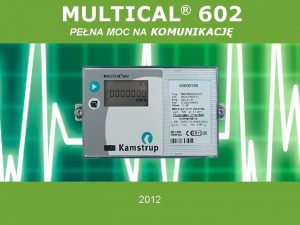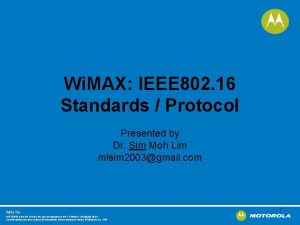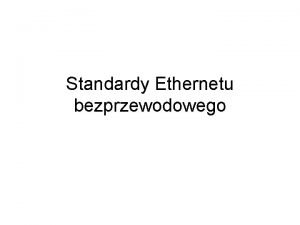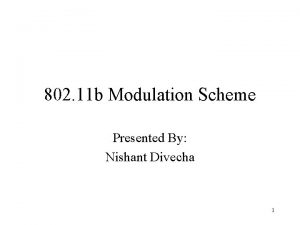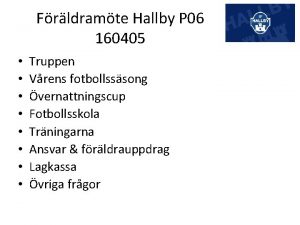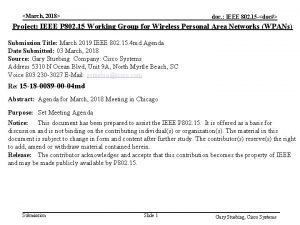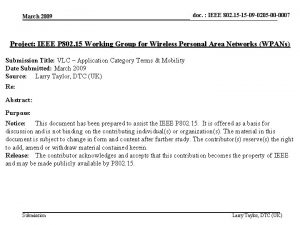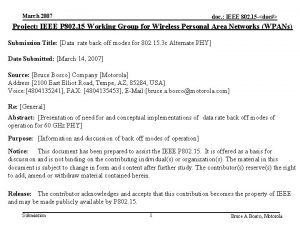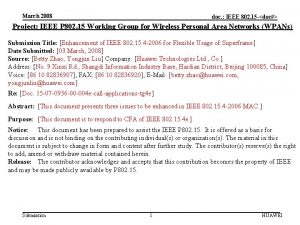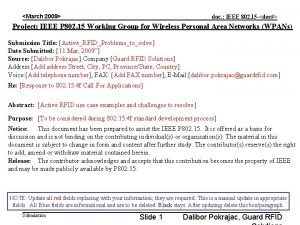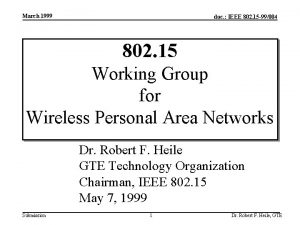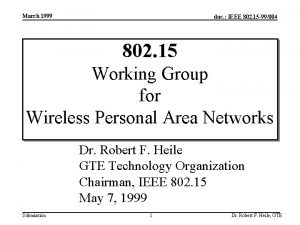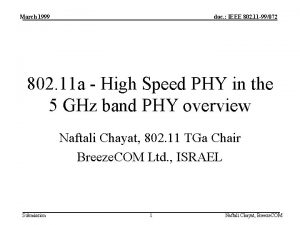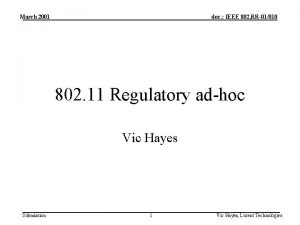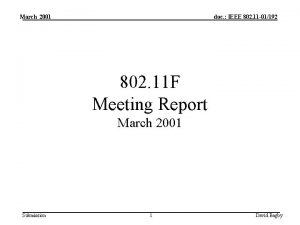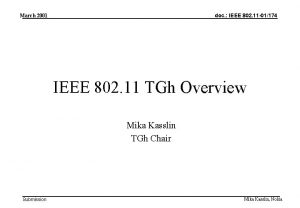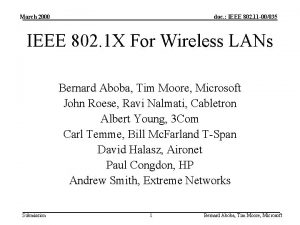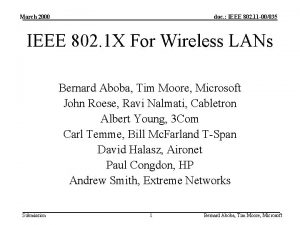March 2016 doc IEEE 802 11 160405 r

















- Slides: 17

March 2016 doc. : IEEE 802. 11 -16/0405 r 0 11 ay DL MU-MIMO BF Training and User Selection Date: 2016 -03 -13 Authors: Submission Slide 1 James Wang, Mediatek

March 2016 doc. : IEEE 802. 11 -16/0405 r 0 Introduction q Benefits of DL MU-MIMO q Aggregation Gain: q reduced number of channel access, reduced overhead associated with short packets q Spatial Multiplexing: q Peak throughput increase: simultaneous transmission of multiple spatial streams. q Possibility of LOS MU-MIMO transmission: Higher throughput and longer range (no need to overcome path and reflection loss associated with NLOS MIMO) q For 11 ay, it is important that DL-MU-MIMO should q Scalable to large number of STAs q Supports 20+Gbps or higher throughput (Ericsson demonstrated 25 Gbps for LTE MU-MIMO downlink http: //www. ericsson. com/news/1987136) q Minimize overhead (BF training, Sounding and feedbacks) Submission 2 James Wang, Mediatek

March 2016 doc. : IEEE 802. 11 -16/0405 r 0 Potential Issues q Hybrid beamforming is the preferred approach for MUMIMO q Issues with digital processing: q q Data in CSI feedbacks increases with # of antennas and number of STAs q Zero-forcing (or block orthogonal) types of operation relies on null space operation. Due to short wavelength at 60 GHz, it might require very frequent sounding and feedbacks (>250 Hz required per STA for <3 d. B degradation) very significant overhead. q Maximal ratio combining or equal gain combining (can be implemented in analog domain if channel is flat, due to narrower beam) is less sensitive to channel variability and narrower antenna beam provides cleaner channel Digital Processing: We believe that good analog BF (with 10 Hz S&F @5 GHz 10 d. B limited digital processing) is essential for degradation (DCN 11 ax. 0858). the reliable MU-MIMO 25 Hz S&F @5 GHz 3 d. B degradation. >250 Hz S&F per user @60 GHz required for <3 d. B degradation Submission 3 James Wang, Mediatek

March 2016 doc. : IEEE 802. 11 -16/0405 r 0 User Grouping and Down-Selection When there a large number of users to select from, it is easier to achieve near mutually orthogonal beamforming to a selected set users Transmission • Desirable operation for MU-MIMO: to UG 1 • MU-MIMO BF training with a large user group. • Divide into smaller sub-groups (with near orthogonal beamforming, similar MCS) for each MU-MIMO transmission. • DL-MU-MIMO transmission to different subgroups Submission 4 Transmission to UG 2 James Wang, Mediatek

March 2016 doc. : IEEE 802. 11 -16/0405 r 0 Overall Flow of MU-MIMO Step 2: Step 4: Step 1: Step 3: Step 5: I-TXSS for Collect TX-RX Pairing Collecting feedbacks MU-MIMO from STAs, send Transmission to TX Sector multiple TX (MID) sector reduction, (combined TXSS MU-MIMO antenna user subgroup feedbacks + R-RXSS after configuration to from STAs selected user TX sector subgroups reductin) User Group 1 RX typically in Omni Submission 5 James Wang, Mediatek

March 2016 doc. : IEEE 802. 11 -16/0405 r 0 Step 1 I-TXSS to allow TX sector reduction via collecting multiple TX sector feedbacks from responder STAs Multiple TX antennas can transmit simultaneously using orthogonal waveforms As number of user in the group becomes large, the benefits of TX sector becomes less significant the number of feedback increases - more overhead the reduction of TX sector is smaller Should only be used when number of user is smaller or number of TX sector/RX sector pairing is large. STA can only send feedbacks if the responder TX BF is updated Submission 6 James Wang, Mediatek

March 2016 doc. : IEEE 802. 11 -16/0405 r 0 Step 2 Collecting multiple TX sector feedbacks • Option 2: Sequential feedbacks Option 1: Polling, feedbacks, (and ACK) • Difficult to synchronize • Less overhead Easier to synchronize with a poll or trigger frame ACK needed ? Submission 7 James Wang, Mediatek

March 2016 doc. : IEEE 802. 11 -16/0405 r 0 Step 3 TX-RX Pairing (MID) Initiator sweep through TX-RX pairings (after TX sector reduction from STAs). Multiple antennas can transmit simultaneously using orthogonal waveform Responder sweep through RX sectors (multiple antennas receive simultaneously) Submission 8 James Wang, Mediatek

March 2016 doc. : IEEE 802. 11 -16/0405 r 0 Step 4 Collecting feedbacks from STAs • Can we assume that STAs are already trained in TX Sectors/Antennas (SLS still up-to-date) for both I->R and R->I direction before MU-MIMO BF training ? • If STA are SLS-up-to-date, AP/PCP can poll STAs or use sequential feedbacks to get feedbacks from STAs • If STAs are not trained in TX Sectors/Antennas (SLS-not-up-todate): • STAs with antenna pattern reciprocity knows their TX sector/antenna, it can send feedbacks to AP/PCP in specific antenna/sector (AP receives with omni-receive antenna) • If STAs have no antenna pattern reciprocity, STAs need R-TXSS on one-by-one basis to able to send feedbacks to AP/PCP • After AP/PCP decide on the antenna configuration for MU-MIMO, transmit antenna configuration to the selected users Submission 9 James Wang, Mediatek

March 2016 doc. : IEEE 802. 11 -16/0405 r 0 Step 4 Collecting feedbacks from STAs Two steps for collecting feedbacks from STAs: 1. Polling (for STAs w up-to-date SLS) 2. Use A-BFT type to allow R-TXSS contentions for STAs w/o up-to-date SLS Multiple channel A-BFT type operation AP only needs one antenna in omni-receive, the other antennas can be RXSS for asymmetric link. AP specify the duration for A-BFT type of operation Collecting feedbacks from STAs PCP/AP Polling or Sequential MU-MIMO Antenna Configuration Feedbacks to selected users A-BFT Type contentions ? Note: PCP/AP allocates one antenna for omni, other antennas can be RXSS to support asymmetric link Submission 10 James Wang, Mediatek

March 2016 doc. : IEEE 802. 11 -16/0405 r 0 Step 5+ MU-MIMO Transmission Step 5: MU-MIMO Transmission to user subgroup Submission 11 James Wang, Mediatek

March 2016 doc. : IEEE 802. 11 -16/0405 r 0 CSI Feedbacks – Option 1 Capacity MIMO Capacity is the metric used in TX/RX Pairing and Sector Selection for MIMO A metric was presented by Panasonic which uses MIMO capacity Due to CE field waveform, it might be more convenient to deal with spatial temporal channel matrix hi, j(τ, t) : channel response of jth TX antenna, ith RX antenna pairing The MIMO capacity is Submission * Note entry in matrix multiplication is done by James Wang, Mediatek 12 correlation.

March 2016 doc. : IEEE 802. 11 -16/0405 r 0 CSI feedback – Option 2 SINR During scalable BF training, the TX antenna/sector and RX antenna/sector pairing are observed by STAs. Additionally, potential interference/leakage between antennas/sectors (which determine the required nulling depth) are also observed. A simplified metric is to feedback SINR from each antenna/sector for SINR computation. This metric is good for predominantly analog beamforming case. Submission 13 James Wang, Mediatek

March 2016 doc. : IEEE 802. 11 -16/0405 r 0 Example of SINR STA 1, STA 2, STA 3 feedbacks the RSSIs of all received antennas/sectors from BF training. AP selects the Antenna/Sector for each STA based on SINR {=S/(I+I+N)} Maximize SINR reduce the burden of digital processing (nulling) Submission (Sector Sweep+R-RXSS) Note: Multiple antennas can transmit simultaneously with orthogonal waveforms Ant 1 Ant 2 Ant 3 AP A 1/S 2 STA 1 Interference RSSI STA s 2 RSSI STA s 3 14 RSSI Signal A 2/S 2 A 3/S 7 James Wang, Mediatek

March 2016 doc. : IEEE 802. 11 -16/0405 r 0 Group ID and PAID Proposed to use group ID for initial scalable BF training. More scalable, predefined. Large group possible – needs new grouping scheme For subsequent DL-MU-MIMO transmission, either use cascaded PAIDs or group ID Accommodate multiple DL_MU-MIMO transmission within a TXOP Submission 15 James Wang, Mediatek

March 2016 doc. : IEEE 802. 11 -16/0405 r 0 Conclusions MU-MIMO BF training and transmission operation are described. Two metrics for CSI feedback are proposed. Submission 16 James Wang, Mediatek

March 2016 doc. : IEEE 802. 11 -16/0405 r 0 STRAW POLL 1 • Do you support to insert into the SFD "11 ay MUMIMO BF support training of more users (including collecting feedbacks from them) than the number of users transmitted to in each MU-MIMO transmission. “ • Yes • No • Abstain Submission Slide 17 James Wang, Mediatek












